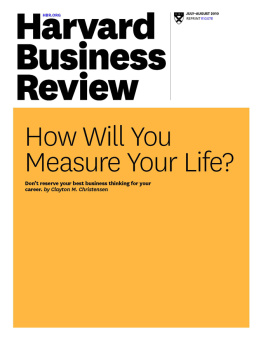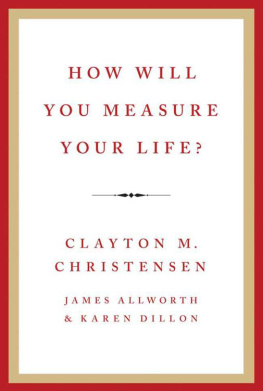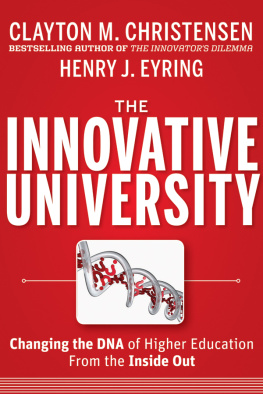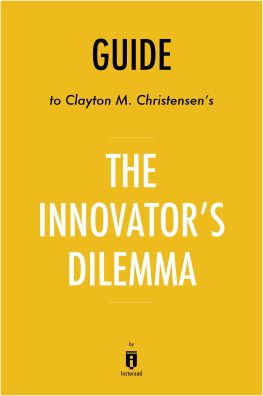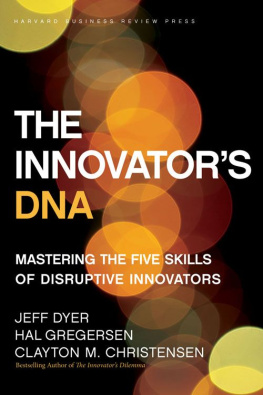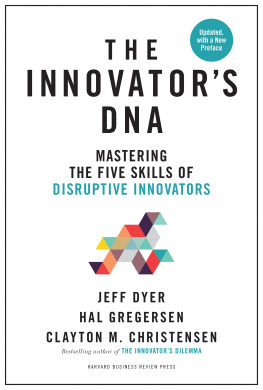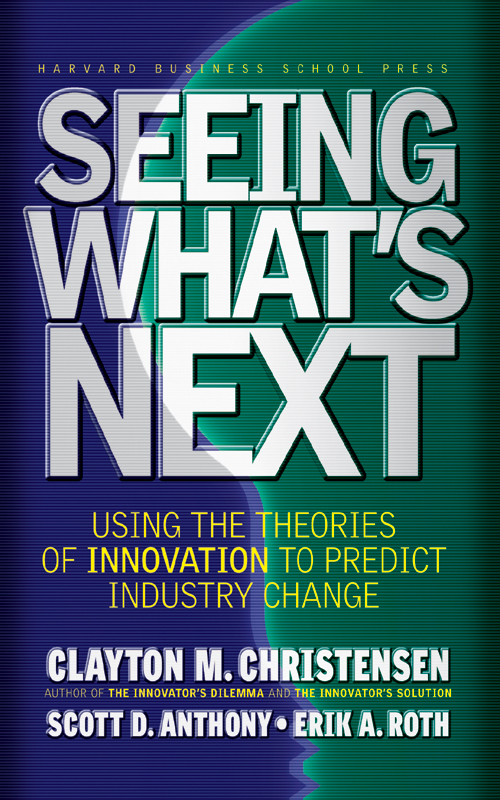Copyright 2004 Harvard Business School Publishing Corporation
All rights reserved.
No part of this publication may be reproduced, stored in or introduced into a retrieval system, or transmitted, in any form, or by any means (electronic, mechanical, photocopying, recording, or otherwise), without the prior permission of the publisher. Requests for permission should be directed to permissions@hbsp.harvard.edu, or mailed to Permissions, Harvard Business School Publishing, 60 Harvard Way, Boston, Massachusetts 02163.
First eBook Edition: September 2004
ISBN: 978-1-59139-185-2
The paper used in this publication meets the requirements of the American National Standard for Permanence of Paper for Publications and Documents in Libraries and Archives Z39.48-1992.
The seeds of Seeing Whats Next were sown almost a decade ago with the publication of the first article describing the phenomenon of disruptive innovation. Readers sensed that the concepts of disruptive innovation were strategically important; but when they asked for guidance in addressing the opportunities and threats that disruption creates, it was hard to offer convincing solutions. Although a few companies had grappled successfully with disruption on occasion, no company had consistently done it well. There just wasnt enough data from the past from which to draw conclusions. Somewhere along the line, I realized that the paralysis I was experiencing had its roots in a flawed paradigm that has guided much of the way we train managers and do research about managementthe belief that decisions should be grounded in solid analysis of data. The problem with this paradigm is that when managers attempt to do something that has not been done before, or when the future is going to be different from the past, the paradigm breaks down. Data is only available about the past. I then realized that with data or without it, every time managers take an action, and every time they look into the future, they use a theory to guide their plans and actionsbecause a theory is a statement of what causes what, and why.
That realization is what led us to write this book. We have attempted to outline a process for using the theories of innovation to predict industry change, even when convincing data is not yet available. We had already written pieces about how disruption might reshape the health care and semiconductor industries and how disruption could be applied at a country level. We further researched these topics and investigated new industries such as telecommunications, education, and aviation to generate a robust way to use theory to predict industry change.
Most of the findings in the book are based on primary and secondary research from sources of the sort that business strategists and analysts would find readily available. We did this to support a key message of this book: The level of ones insight is not strictly a function of the level of ones access to unique or proprietary information. Armed with the right concepts, anyone can produce insights that surpass those of analysts who are knee-deep in industry minutiae.
We apologize to two groups of readers: those from outside the United States and those looking for detailed financial formulas. Most of the booksave for focuses on developments within the United States. In our increasingly global economy, this is clearly an over-simplification. The tools we provide in this book for using the theories of innovation, however, are applicable globally. Strategy and innovation are somewhere between unguided trial-and-error experimentation and rules-based science. Thus the tools in this book are designed to help strategists and planners recognize patterns and interpret the meaning of events as they unfold. Pattern recognition is the best mode of decision making at this point, given the present state of knowledge. Formulas and rules are not yet feasible.
Building comprehensive theory is an iterative process. The lap around the theory-building track in The Innovators Dilemma built the basics of the core theory. The lap around the track in The Innovators Solution detailed important additional theories and began to show how to put the theories into action. This lap continues along the identification and application trackshowing how to identify circumstances and understand the implications of those circumstances. The next lap should move toward developing more detailed metrics that indicate circumstances and quantifying the implications of those circumstances.
Listing three authors for this book is quite disingenuous. Dozens of people helped us develop and refine the thoughts in this book. Research partners and former students Sally Aaron, Dan Abassi, Will Clark, Raj De Datta, Carl Johnston, Dr. John Kenagy, Marie Mackey, Michael Raynor, Nate Redmond, Dr. Chris Robison, Chirag Shah, David Sundahl, and Matt Verlinden each contributed a great deal to the ideas in the book.
We owe a particular debt to the industry and topical experts and friends who helped refine important pieces of Seeing Whats Next. Jeff Campbell, Pete Cornell, Robert Crandall, John Earnhart, Alexander Edlich, Paula Ford, Lib Gibson, Kevin Goodwin, Joe Graba, Dr. Jerry Grossman, Stuart Hart, Reed Hundt, Laura Ipsen, David Isenberg, Kevin Kennedy, Steven King, Ted Kolderie, Rick Krieger, Gina Lagomarsino, Eric Mankin, Bob Martin, Neale Martin, Joel Meyerson, Steve Milunovich, Bernard Nee, David Neeleman, Stagg Newman, Bob Pepper, Wilfred Pinfold, Michael Putz, Nagi Rao, Rick Rotondo, Chris Rowen, Tim Sloan, Donna Soave, Justin Steinman, Sue Swenson, Tony Ulwick, Jon Wilkins, and Ron Wolk each helped us fine-tune the thoughts presented here.
We would like to thank a number of colleagues at Harvard who were particularly helpful in this effort: professors Liz Armstrong, Dr. Richard Bohmer, Tom Eisenmann, Clark Gilbert, Tarun Khanna, and Steve Spear. My office manager, Christine Gaze, has helped with patient competence in ways too numerous to count. Hollis Heimbouch, whose deft editorial hand has helped to shape this manuscript, has been a wonderful, supportive editor. All of these people have helped build what you are about to read.
I am particularly grateful to my coauthors, Scott Anthony and Erik Roth, and their wives for dedicating a couple of years in the prime of their lives after they finished our M.B.A. program to write this book with me. Whereas my own mind seems to work best with abstractions and concepts, they have demonstrated greater intellectual agility as they helicoptered up and down between exploring high-level concepts and developing practical tools for using them. Over the years in my classroom, Ive developed a pretty good eye for capable students. Scott and Erik are two of my very best. They have done most of the work and writing in this book. I am honored to have their names next to mine on the cover.
As with the other books I have written, my wife, Christine, and my children, Matthew and his wife Elizabeth, Ann, Michael, Spencer, and Katie, have patiently helped me bounce these ideas around at home and in the car. I love them and am grateful that I belong to them forever.
Clayton M. Christensen
Boston, Massachusetts
H arvard Business School Dean Kim Clark likes to refer to the HBS experience as transformational. I was highly skeptical until I walked into Clayton Christensens class in the fall of 2000. I had found my transformational experience. Clay is a walking paradox: brilliant but humble; conceptual but practical; an academic with real-world experience; highly successful yet willing to bend over backward to help anyone in need. He struck a chord that changed not only the course of my Harvard experience, but my career trajectory as well. I am eternally grateful that he has provided me the opportunity to help take his ideas in new, exciting directions. Special thanks as well to my other coauthor, Erik Roth. Eriks unique perspectivethoughtful, inquisitive, analytical, and always provocativehelped me look at concepts in valuable new ways. Many important concepts resulted from hours of invigorating debate between Erik, Clay, and me.


